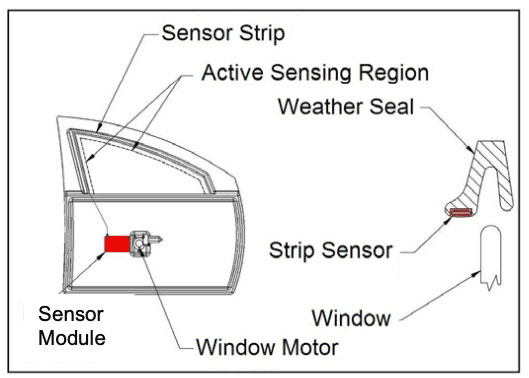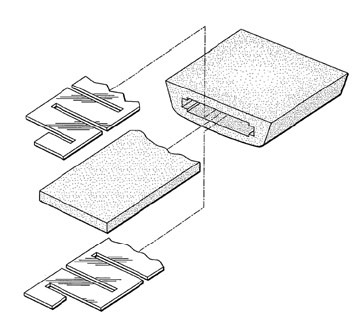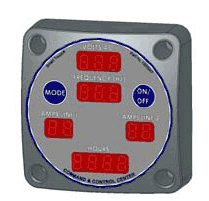
Capacitive sensing automotive in an electric environment
ABSTRACT
Capacitive sensing automotive allows protection in power windows, sunroofs, liftgates, and sliding doors. It also provides greater design freedom for operator interfaces, including switch entry and fingerprint sensing. Fingerprint sensing adds new levels of security for the access and start of a vehicle, thus allowing for the elimination of keys.
For this purpose the paper describes the design and operation of various systems that could employ capacitive sensing technology, including keyless entry, operator controls, and safety-related sensing. Also discussed are vehicle installation, safety enhancement, and ergonomic benefits.
DESIGN
- The design goals of Capacitive sensing automotive are:
Produce automotive sensor systems that will prevent trapping, injury, or death due to moving panels such as windows, sunroofs, and power lift gates - Provide unique and ergonomically beneficial operator interface solid-state controls and surfaces
- Provide for fingerprint recognition of designated individuals for vehicle access and operation.
- Description
A capacitive sense system in a moving panel application generates a space-charge field in the moving panel opening. To explain this field detects a person’s presence and provides the information required to control the panel safely.1
The system comprises two major components, the first being a module that integrates the motor, gearing, and electronic control into a single package. This module controls and drives the moving panel mechanism. The second component is a sensor strip positioned onto an appropriate surface relative to a moving panel. A typical location would be parallel to the weather seal. A manufactured weather seal with the sensor embedded is best. The system works by measuring the change in capacitance of the sensor. When sensing an undesirable change, the moving panel is halted, reversed, or not allowed to move.
Function and layout.
Capacitive sensing can provide unique control and switch placement opportunities in function and layout. This gives greater flexibility to the interior designer regarding surface finishes and general form.
For example, touch switches can be employed using capacitive sensing instead of conventional mechanical switches, including membrane contact switches similar to those used on the GM graphic displays. The touch surface can use various textures and ridges to guide the user to different locations on a panel. Additionally the panel can have different form characteristics, such as flat, simple curved, or compound curved surfaces. This provides the designer with many visual and ergonomic possibilities and advantages.
Solid-state Capacitive sensing automotive switching, AC and DC technology, is described in US Patents 4,731,5482 and 4,758,735.3
Transforming automotive electronics
Apple’s iPod and iPhone use capacitive sensing, described as an “elegant solution” in the article “How Apple has transformed automotive electronics” in the August issue of Automotive Design and Production4 magazine.
Biometric sensing is becoming prevalent in many facets of society; automotive applications are no exception. It is common for computers to have fingerprint scanners, like some cell phones, PDAs, and flash drives. Some banks are using biometrics for account access control, and portable fingerprint scanners are in use by some police departments. While using different techniques for sensing different biometric characteristics, this paper will focus on capacitive sensing.
Capacitive sensing automotive for SAFETY
Capacitive sensing in an automotive environment has always been a challenge. Wide extremes in temperature and humidity present formidable obstacles. However, in recent years techniques have evolved to allow for reliable detection of small changes in capacitance. This allows capacitive sensing for entrapment detection in windows, sunroofs, and motorized doors. Showing a capacitive sensor strip in a door window weather seal in Figure 1, and an example of the strip’s construction in Figure 2.

Figure 1 – Strip sensor embedded in weather seal

Figure 2 – Strip construction
Further uses are now being contemplated for in-vehicle sensing. These include seat occupancy detection, child safety seat detection and identification, and occupant location detection.
Embedding sensors could implement occupancy detection in a typical automotive seat and seatback. The sensors can be used to determine the absence or presence of an occupant and determine the approximate location and position of an occupant. The information provided could enable and control airbag deployment based on occupant presence and position detection.
Capacitive sensing automotive for design freedom
The use of capacitive sensing allows design freedoms that are not possible with conventional through-the-dash switches. Designers can create flat or curved surfaces with legends imprinted on them defining desired functions. No thru-hole features are required for switch and knob shafts. An example of such a design in Figure 3 shows two touch switches on the control generator’s control located on a fire truck. All circuitry, including the switches, is located behind a solid plastic housing. This greatly enhances the switches’ reliability and circuitry in general because multiple leak paths are eliminated.

Figure 3 – Control using touch switches
Touch surfaces can enable the designer to implement intelligent touch controls that respond to touch, tap, and slide commands similar to computer touchpads or touchscreens.
The ability to recognize touch presence, location, and motion enable designers to implement more sophisticated functionality in automotive controls. The added flexibility of the touch switches allows for a few switches to have multiple functions, thus reducing the total switch count. A block diagram of a typical method for determining capacitance on a sensor is shown in figure 4.
Sensor Module

Figure 4 – Block diagram of capacitive sense circuitry
A detailed description of capacitive sensing design aspects can be found in US Patent 7,162,9285.
Multi-finger touch entries
Touch surfaces can also recognize multi-finger touch entries similar to the iPhone and character recognition like some PDA (Personal Digital Assistant) devices. For example, a touch screen could recognize a finger drawing the letter ‘M’ and present a map for navigation. The map could then be touched to indicate “from” and “to” locations to show detailed directions. The touchscreen could recognize the pinching or opening of two fingers to zoom out or in on the map. The ability to touch provides intuitive navigation control.
The ability to have slide control opens up many possibilities of variable control covering environment, entertainment, and electromechanical items. Electromechanical functions include window and sunroof control and mirror, pedal, and seat position.
Environmental functions include:
- Cabin / trim lighting brightness and color.
- Temperature for the cabin and heated seats.
- Air direction (i.e., floor, defrost, vent).
And entertainment functions include volume, location/position in a video or audio presentation, brightness/contrast of displays.
A touch surface can provide touch / no-touch information as described above and can also provide biometric information that can be used to identify an individual.
Capacitive sensing for security
Capacitive sensing provides enhanced security by linking authorization to a unique biometric. A system that senses a particular biometric, such as an iris or retina pattern, or a fingerprint, can be used as authorization to access and use a vehicle. The biometric used should, of course, be unique so that an extreme level of confidence can be established that the person requesting an action is indeed authorized to perform the task. While much unique biometrics could be used, a simple capacitive touch sensor provides the security needed with less complexity and cost than other types of systems.
Fingerprint Sensing
A fingerprint sensor can enable keyless entry designs. This would make it such that only authorized persons could unlock and obtain access to a vehicle or perform various functions. The system could unlatch a door or even open it automatically. Driver and passenger environment preferences, such as seat position, temperature settings, radio stations, etc., could be changed based on the recognition of a particular person.
A simple touch-based could also start the vehicle on fingerprint authorization. Likewise, lesser permissions could be given that provide particular capabilities such as entertainment and window control.
Fingerprint sensing offers new levels of vehicle access control and opens the possibility of harm to the occupant to gain vehicle access and control.6
Live detection could be used to help ensure that the fingerprint is from an attached member of a living person. The sensor would not only detect fingerprint patterns but would detect that the subject is alive, possibly through hemoglobin/oxygen sensing or other sensing means. This will reduce the possibility of harm coming to an occupant gaining access to the vehicle.
Recommendations for further work
Capacitive sensing technology is well established and can be implemented into the automotive environment now. It is simply up to the various styling or technical teams in the automotive sector to implement its use in the myriad applications available, including those outlined in this paper.
Conclusions
- Capacitive sensing protects occupants from the danger associated with power window and door closures.
- The use of capacitive sensing enhances design freedoms.
- The implementation of biometric sensing improves security and control.
REFERENCES
- 1 Kirby, Erin, Newman, Todd. “Child Safety via anti-trap proximity technology,”01-1484, SAE International, Warrendale, Pennsylvania.
- 2 Ingraham, Ronald D., inventor; Nartron Corporation, assignee. Touch Control Switch Circuit. United States patent US 4731548. Mar 15.
- 3 Ingraham, Ronald D., inventor; Nartron Corporation, assignee. DC Touch Control Switch Circuit. United States patent US 4758735. Jul 1.
- 4 Kelly, Kevin. “How Apple Has Transformed Automotive Electronics.” Automotive Design and Production Aug. Gardner Publications, Inc. May 22. <http://www.autofieldguide.com/articles/080701.html >.
- 5 Shank, David W., inventor; Nartron Corporation, assignee. Anti-entrapment System. United States patent US 7162928. Jan 16.
- 6 Kent, Jonathan. “Malaysia car thieves steal finger.” BBC News Mar 31. May 22. <http://news.bbc.co.uk/2/hi/asia-pacific/4396831.stm>


